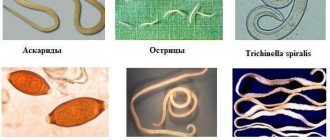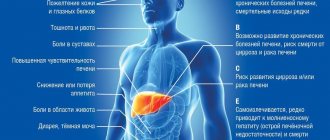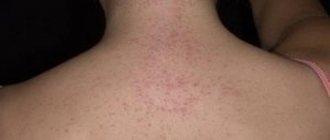Hymenolepiasis – one of the most common human contact helminthiases. The causative agent is the dwarf tapeworm, less commonly the rat tapeworm. A stool test for hymenolepiasis is carried out to confirm the diagnosis, as well as when passing a medical commission (before entering work in the catering industry, also in a kindergarten). The study is based on the detection of helminth eggs in feces.
Pathogens
Rat tapeworm
Rat tapeworm under an aileron microscope
Rat tapeworm is a cestode (tapeworm) that primarily infects rodents, but can sometimes be diagnosed in humans. An adult helminth has a length from 20 to 60 cm and a width from 2 to 4 mm. Hymenolepis diminuta is distributed in various areas of the world and requires arthropods as an intermediate host. Eggs consumed by arthropods develop into cysticercoid larvae. Rodents become infected by ingesting infected insects (humans can be accidentally infected through the same mechanism).
The risk of human infection with rat tapeworm is very low, since rats are its main host. It is also known as rat tapeworm. Adult H. diminuta live and mate in the intestines of rats. The parasite's eggs are passed in feces, which are often consumed by arthropods. Once inside the insect, they mature into a cysticercoid. These larvae burrow their way from the insect's intestines into its circulatory system using their three pairs of hooks. There, they wait for the rat to eat their first owner and become their second. Then they mature in it into an adult form, begin to lay eggs and restart the entire cycle.
Rat tapeworm has an effective mechanism of influence on beetles. Due to this, they prefer to ingest rat excrement, which contains parasite eggs, due to its smell. It is not known for certain whether this smell is emitted by eggs or the feces of a sick animal themselves. In addition, the rat tapeworm sterilizes the female beetle so that she does not waste energy on reproduction. This gives the parasite the opportunity to conserve the insect's metabolic resources for its own purposes.
Dwarf tapeworm
Dwarf tapeworm under an electron microscope
Dwarf tapeworm is the smallest cestode (adult length 15-40 mm) parasitizing the human body, and the only representative of this class that does not require an obligatory intermediate host, since it is able to pass through all stages basically. Helminths of this species are the most common cause of all cestode infections and are found throughout the world (most often in temperate regions - Africa, South America, Asia and Europe). Children suffer from hymenolepiasis more often than adults.
The most common intermediate hosts of dwarf tapeworm are insects such as flour bugs and fleas. When the egg enters the definitive host, it matures and a six-hooked larva called an oncosphere emerges. It penetrates the villi of the small intestine, where it develops into a cysticercoid.
Transmission of the dwarf tapeworm occurs through the fecal-oral route. And also if an insect containing a cysticercoid accidentally enters the body, which happens much less frequently.
Disease prevalence and symptoms
Most often, the source of hymenolepidosis is dirty objects from the street that children play with. As a result of infection, the child’s immunity is greatly weakened, and other concomitant diseases appear. Adults can become infected with hymenolepiasis through poorly washed fruits and vegetables, dirty hands, and in rare cases through contaminated dust when inhaled.
As the disease develops, patients experience a sharp deterioration in the general condition of the body and a weakening of the immune system.
If a person experiences frequent headaches, lack of appetite, nausea, dizziness, pain in the intestines, problems with stool, sleep disturbances and constant irritability, then doctors recommend testing for hymenolepiasis.
Infection
The small mealworm is the most common first intermediate host in Ukraine and Russia.
It is a flour pest and therefore lives wherever grain and flour are stored. The causative agents of hymenolepiasis live in the intestines of rats and mice and are common in warm climates. The eggs are released as part of the feces of these rodents, which are then eaten by their second intermediate hosts - arthropods (insects, etc.). There they mature into a form called cysticercoid. But dwarf tapeworms, unlike rat tapeworms, can pass through all their stages of development in the human body. For him, additional hosts are not mandatory.
Humans and other animals become infected when they eat insect-contaminated materials, whether intentionally or not. In an infected person, the development of parasites in the body ends, so they can live there for many years if not treated.
An infected small mealworm (pictured) can easily be eaten by rodents and humans while eating flour products, causing hymenolepiasis infection. Since heat treatment is usually not enough to kill the parasites inside the beetle that got into the flour product along with the flour.
People become infected with dwarf tapeworm much more often than with rat tapeworm. Because in addition to spreading through insects, hymenolepiasis, caused by this parasite, can be transmitted from person to person directly through eggs in the stool (personal contact). Such an infection occurs much more often, especially considering that the eggs of the dwarf tapeworm are immediately infectious. After ingestion, the larva (oncosphere) emerges from the egg, encapsulates in the intestinal wall and develops into a cysticercoid and then into an adult worm, without intermediate hosts.
Due to the wide distribution of the dwarf tapeworm and its development paths, hymenolepiasis is found throughout the world. The severity of the infection may increase over time as these parasites are able to reproduce without leaving their host.
Do I need to be tested for hymenolepiasis to visit the pool?
Hymenolepiasis is directly transmitted between people. This is especially true for public areas. Tapeworms are highly contagious, so to visit the pool you must present a certificate indicating that you are not infected with helminths.
Before submitting a sample, you must follow important recommendations:
- The study must be done in the morning.
- Before the procedure, it is not advisable to wash your face or visit the toilet, otherwise you may wash the eggs off the skin.
- To carry out the analysis, adults need to contact their general practitioner for a referral, and children should contact their pediatrician.
- Usually the result is ready by the next evening.
Prepare containers in advance. It is not advisable to use regular jars. You must wear sterile gloves on your hands.
Sometimes a specialist allows you to collect stool yourself. In this case, you should follow certain methods:
A special container is taken, which represents a plastic test tube, inside of which there is a cotton swab. They touch the anus area with it, and then put it back into the container, which is tightly closed.
The second method uses clean glass and clear adhesive tape. It is applied to the anus, and after a few seconds it is glued to the surface of the glass.
If the fence is carried out independently, then you should ensure that the cotton swab, tape and glass are clean, otherwise the result will be false.
Read more in our article: What tests does a child need to undergo before visiting the pool?
Symptoms
When dwarf tapeworm worms enter the human intestine, they cause inflammation of the mucous membrane. As a result, inflamed tissues have a reduced ability to absorb nutrients.
Signs of hymenolepiasis may include:
- weakness;
- slight increase in temperature (up to 37.5 0);
- stomach ache;
- irritability;
- loss of appetite and anorexia;
- diarrhea;
- pale skin;
- allergic reactions on the skin;
- itching around the anus;
- nasal itching.
Rare symptoms include increased appetite, vomiting, nausea, bloody diarrhea, rash, limb pain, headache, dizziness and behavioral disturbances. Sometimes infected children experience epileptic seizures.
Symptoms in humans are due to an allergic reaction or systemic toxicosis caused by the parasite's waste. The severity of symptoms depends on the degree of infection of the body. With intense infestation (more than 2000 worms in the body), attacks of severe abdominal pain, convulsions, loss of consciousness, and memory impairment are observed.
However, very often (about 30% of cases) the disease is asymptomatic.
Pathogenic effect of dwarf tapeworm on the human body.
- mechanical damage to the walls of the small intestine, necrosis of the villi of the intestinal mucosa (necrosis, ulcers at the attachment points, sometimes down to the muscle layer) due to the impact of scolex hooks and tapeworm parasitism; - sensitizing effect (development of an allergic mood in the body and toxic-allergic reactions) due to waste products and decay of the parasite; — intestinal microblood loss with the development of anemia; - development of intestinal dysbiosis and vitamin deficiency C, B2, PP.
Diagnostics
The main method for diagnosing hymenolepiasis is microscopic examination of pathogen eggs in feces. It is advisable to test stool for worm eggs three times with an interval of 7-10 days. Moreover, before taking the tests, the patient is prescribed anthelmintic drugs for the intensive release of eggs and parts of worms from the body.
If microscopic examinations are ineffective due to a low number of eggs in the stool, diagnosis is carried out using the enrichment method. It makes it possible to concentrate more eggs in one place in the feces. To do this, the specialist prescribes Fenasal to the patient.
How to pass
A comprehensive analysis for hymenolepiasis consists of the following procedures:
- general and biochemical blood tests;
- microscopic examination of stool to identify helminth eggs.
The second examination is the main one in the diagnosis of hymenolepiasis. To determine infection with parasites, 2 methods are used:
- microscopy of feces with collection of biomaterial after 2-3 weeks. This interval is associated with the characteristics of the life cycle of adult worms. The method is effective only if there are a large number of larvae in the feces. In case of massive invasion, examining the native smear under a microscope is sufficient;
- enrichment method - used for minor intestinal worm damage or low egg production. This diagnosis has a number of contraindications, so it is carried out only after being prescribed by the attending physician.
A few days before the test, it is recommended to stop taking medications.
All tests are taken in the morning on an empty stomach. The last meal should be no later than 8-10 hours. A few days before the test, it is recommended to stop taking medications. You must inform your doctor about the use of any medications. Adult patients should stop drinking alcohol and smoking on the eve of the study.
The presence of hymenolepiasis can be detected by a blood test.
An increased white blood cell count, a high erythrocyte sedimentation rate, and the presence of anemia may indicate the development of a parasitic disease. Blood for hymenolepiasis is also donated in the morning. Preparation for blood diagnostics is similar to that for microscopic examination of stool.
Pool analysis
Due to the danger of infection and mass infestation by helminths, analysis to determine parasites is often required when children enter preschool or school institutions, as well as to the swimming pool.
After examining the biomaterial, the doctor issues a conclusion about the absence of helminths.
Testing for worms for the pool is carried out by donating stool (smear) or blood. After examining the biomaterial, the doctor issues a conclusion about the absence of this disease. The certificate is provided to the swimming institution.
Treatment
Difficulties in treating hymenolepidosis are associated with the possibility of autoinvasion (self-infection). Therefore, therapy can be long-term.
Traditional remedies
Drug treatment of the disease involves taking anthelmintic drugs: Praziquantel, Niclosamide (outdated compared to the previous one), Nitazoxanide, Phenasal, male fern extract.
Praziquantel as a single dose (25 mg/kg) is now the drug of choice for the treatment of hymenolepiasis and has an efficacy of 96%. One dose of Albendazole (400 mg) is also very effective (>95%).
A three-day course of nitazoxanide is 75-93% effective. The dose is 1 g per day for adults and children over 12 years of age; 400 mg per day for children ages 4 to 11 years; and 200 mg – from 3 years or less.
Vitamins, complexes of macro- and microelements, and general strengthening drugs are taken as auxiliary means. During the entire treatment cycle, it is necessary to eat properly and observe personal hygiene rules.
Traditional methods
Of the traditional methods of treating hymenolepiasis, the most effective is the use of raw pumpkin seeds or an infusion of them. When consuming raw seeds, it is necessary to peel them, but leave the green crust, which contains the bulk of the substances that paralyze worms. To obtain an infusion, you need to mix 500 grams of peeled and crushed seeds with 5 cups of boiled water. Place the resulting mixture on the fire and heat until half the liquid evaporates. After this, strain the infusion through cheesecloth (after removing the resulting layer of oil on top). Children should take from 75 to 100 g per day depending on age, adults – 150 – 200 g.
Any folk remedies for the treatment of hymenolepiasis should be used only as an additional treatment after therapy with traditional remedies.
Helmostop program: instructions for use
So, here are the instructions for using this anti-parasitic complex:
Stage 1. Duration – 10 days:
- In the morning: 1 spoon (included in the package) of the drug "Maxfiber Beri".
- During the day: 1 tablet “Hepatocholan”, 2 capsules “Vitaspectr XL”.
- In the evening: 1 sachet of Atlant Plus tea.
At this stage of therapy, the intestines are cleansed, the flow of bile is accelerated and the immune system is stimulated.
Second phase. Duration – 30 days:
- In the morning: 2 Hercules capsules.
- During the day: 2 tablets of “Indole plus” and “Hepatocholan”.
- In the evening: 2 pills each “Hercules” and “Uncaria”; 1 sachet of Atlant Plus herbal tea (every other day).
At this stage of treatment, the process of deworming occurs and the outflow of bile accelerates.
Third stage – duration – 10 days:
- In the morning: 1 scoop of Maxfiber Beri and 2 capsules of Vitaspectr XL.
- During the day: 2 tablets “Uncaria” and 2 tablets “Hepatocholan”.
- In the evening: 1 serving of Maxfiber Berry medicine and 1 sachet of Atlant Plus tea.
At this final stage, the process of removing helminths and bile is accelerated, the intestines are cleansed, the immune system is stimulated and possible allergy symptoms are reduced.
Prevention
Although pygmy tapeworm infection is not serious in most cases, long-term infection can lead to dangerous complications. Compliance with basic preventive rules will help prevent infection with this helminth:
- control of insects, especially fleas and grain pests;
- preventing fecal contamination of food and water in institutions and crowded places is of paramount importance;
- It is necessary to wash your hands with warm running water and soap after visiting the toilet, changing diapers and before preparing food;
- When traveling in countries where there is a risk of infection, you should always wash, peel and heat all raw vegetables and fruits with clean running water;
- elimination of infected rats.
Particular attention should be paid to the observance of preventive measures by employees of kindergartens and other children's institutions.
Research results
The result of the analysis may be positive or negative. If the answer is negative, the patient does not have hymenolepiasis. The doctor issues a certificate indicating the result obtained.
The presence of a positive answer indicates the fact of infection with helminths.
This situation requires immediate treatment. The necessary course of cyclic therapy, taking into account the clinical picture, is prescribed to the patient by the attending physician. Ignoring the disease or self-medicating can lead to the development of chronic hymenolepiasis.
Even after complete healing, the patient must be observed by a parasitologist for six months.
It is important to remember that treating pathology is a long process consisting of several stages. And even after complete healing, the patient must be observed by a parasitologist for six months and periodically undergo appropriate tests.
Enterobiasis
The main method for detecting enterobiasis is scraping. The accuracy of the method is approximately 50% and this is a pretty good result. The analysis can be carried out in a commercial medical institution or clinic at the place of registration. The patient can also scrape it independently and take it to a medical facility for further diagnosis.
Scraping allows you to identify enterobiasis: indicates the presence of pinworms or their absence.
The patient can get tested for enterobiasis independently. It is better for the patient to collect scrapings in the morning after sleep; in no case should the patient undergo water procedures or empty the stomach. To take a scraping without the help of doctors, you will have to adhere to the following rules:
- Use a sterile sample collection kit, which the patient independently applies to the anus. The sample is then placed in a sterile package and carried for diagnosis.
- Using adhesive tape and a glass slide. The patient must independently apply adhesive tape to the anus, which is subsequently glued to the glass.











